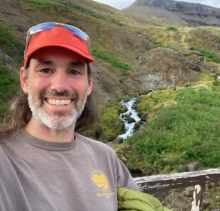You are here
Bullard Spotlight: Michael Dietze on Harvard Forest's Carbon Cycle Forecasting

Driven by a variety of factors across space, time, and processes, the predictability of the carbon cycle helps decision-makers improve forest monitoring and better understand changes in ecosystem services. During his Bullard Fellowship, Michael Dietze - who runs the Ecological Forecasting Lab at Boston University - is laying the foundation for future research that improves carbon forecasting at a regional scale, integrates additional data constraints into forecasting systems, and drives adaptive approaches to data monitoring & collection.
During his Fellowship, Michael plans to use Harvard Forest as a testbed and anchor site for near-term iterative ecological forecasts of the terrestrial carbon cycle. As part of his lab's prior research, his team has stood up a carbon cycle forecast for Harvard Forest that runs daily to predict carbon and water pools and fluxes out 35 days at an hourly timestep. He's currently extending the tower-scale forecast to run across a grid at a landscape scale. "I’m focusing on the 5x5km NEON airborne observatory platform footprint, and producing a 30x30 meter resolution set of predictions for all pools and fluxes over time. I’ve got this to run for a period of time in the past and am in the process of getting it set up to run every day with the data assimilation," he explains. This sort of spatial forecast has a lot of potential value to land managers and landscape-scale carbon accreditation projects.
This summer, Michael joins other Harvard Forest mentors to work with Summer Research Program in Ecology interns to explore the idea of adaptive moniroing. Two students are using forecasts dynamically to make decisions about what variables to measure and where. Specifically, these students will be monitoring tree growth and soil respiration across different plots in Harvard Forest, and then using those measurements to validate the forecasts in real time.
For example, depending on the weather forecast for different temperatures and precipitation (e.g. cool and wet vs. hot and dry) his team might decide between measuring soil respiration at upland sites instead of in the woody wetlands because the forecast might be more uncertain for those locations. Most conventional monitoring protocols follow a static design (fixed plots, fixed remeasurement frequency); by being adaptive, his team will explore the potential to (1) gain more information for the same effort (e.g. pick up interesting events) or (2) gather the same information with less effort (e.g. avoid collecting data under well-researched conditions and instead prioritize those that are novel or more uncertain).
Michael was drawn to Harvard Forest because, as he states, "on a global scale, Harvard Forest is a hotbed for carbon cycle science, with a wide range of long-term monitoring efforts at the intersection of all the major research networks (NEON, LTER, Ameriflux, Phenocam, ForestGEO, etc.). If someone has figured out a way to measure something about the terrestrial carbon cycle, they’ve probably tried it here. As such, it is the ideal testbed for scaling out our carbon cycle synthesis and forecasting work."

